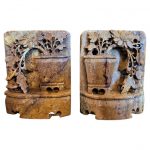Pair of Chinese Famile Verte and Coral Tall Table Lamps
PRESENTING A GORGEOUS Pair of Chinese Famile Verte and Coral Tall Table Lamps.
Mod 20th Century circa 1960-80.
These are Chinese export in the Famile Verte pattern famous in Canton Region of China.
Beautiful detail with Courtesan’s in landscape/garden scenes. Green, white, yellow and unusual purples.
The top sections and the bases plinths are coral in color and we believe are a type of cinnabar.
Each has a slightly different polished coral finial.
Fully working and in very good condition with no chips or cracks.
THESE ARE A VERY DESIRABLE AND IMPOSING PAIR OF LAMPS !
Famille jaune, noire, rose, verte are terms used in the West to classify Chinese porcelain of the Qing dynasty by the dominant colour of its enamel palette. These wares were initially grouped under the French names of famille verte (“green family”), and famille rose (pink family) by Albert Jacquemart in 1862. The other terms famille jaune (yellow) and famille noire (black) may have been introduced later by dealers or collectors and they are generally considered subcategories of famille verte. Famille verte porcelain was produced mainly during the Kangxi era, while famille rose porcelain was popular in the 18th and 19th century. Much of the Chinese production was Jingdezhen porcelain, and a large proportion were made for export to the West, but some of the finest were made for the Imperial court.
Famille verte (康熙五彩, Kangxi wucai, also 素三彩, Susancai), adopted in the Kangxi period around 1680, uses green in a few different shades and iron red with other overglaze colours. It developed from the wucai (五彩, “Five colours”) style, which combines underglaze cobalt blue with a few overglaze colours. The famille verte enamels may be painted on the biscuit (unglazed prefired ware) with no underglaze blue, or over high-fired glaze, producing wares of different appearances. Wares with enamel painted on the biscuit usually have a solid-colour ground such as yellow, black or green, while those painted over the glaze may have a white ground. Occasionally both underglaze and overglaze blue may be seen in the same object. The firing to fuse the enamels was done at a relatively low temperature.
The colours found in famille verte are typically green, red, yellow, blue and aubergine (non-vivid purple). Black may also be used and occasionally gold. The blue colour is more violet or royal blue in tone, which is different in shade from the blue used in Ming dynasty porcelain. The ability to achieve colour gradation famille verte is limited. The coloured enamels are often painted over the pure white body of the porcelain which comes over through the glaze. The colours may also be set off on a black or yellow grounds (known as famille noire and famille jaune respectively), and more rarely aubergine and green.
Famille verte wares were popular for several decades until the 1720s after the reign of Kangxi when it became supplanted by famille rose which has a greater colour range. It continued to be made in small amounts in the subsequent periods, and its popularity revived in the West in the late 19th and early 20th century
Link: https://en.wikipedia.org/wiki/Famille_jaune,_noire,_rose,_verte
Pair of Chinese Famile Verte and Coral Tall Table Lamps.
Provenance: From a Quality Dallas Private Collection.
Condition: Very Good.
Dimensions: 37 inches Tall with a shade diameter of 20 inches.
PRICE: $4,000 – SALE PRICE NOW: $2,520 (Pair)




































